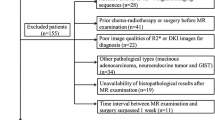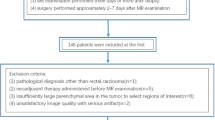Abstract
Objectives
To investigate the utility of 3D amide proton transfer (APT) MRI in predicting pathologic factors for rectal adenocarcinoma, in comparison with diffusion kurtosis imaging.
Methods
Sixty-one patients with rectal adenocarcinoma were enrolled in this prospective study. 3D APT and diffusion kurtosis imaging (DKI) were performed. Mean APT-weighted signal intensity (APTw SI), mean kurtosis (MK), mean diffusivity (MD), and ADC values of tumors were calculated on these maps. Pathological analysis included WHO grades, pT stages, pN stages, and extramural venous invasion (EMVI) status. Student’s t test, Spearman correlation, and receiver operating characteristics (ROC) analysis were used for statistical analysis.
Results
High-grade rectal adenocarcinoma showed significantly higher mean APTw SI and MK values (2.771 ± 0.384 vs 2.108 ± 0.409, 1.167 ± 0.216 vs 1.045 ± 0.175, respectively; p < 0.05). T3 rectal adenocarcinoma demonstrated higher mean APTw SI and MK than T2 tumors (2.433 ± 0.467 vs 1.900 ± 0.302, p < 0.05). No kurtosis, diffusivity, and ADC differences were found between T2 and T3 tumors. Tumors with lymph node metastasis and EMVI involvement showed significantly higher mean APTw SI, MK. No difference was found in diffusivity and ADC between pN0 and pN1-2 groups, and EMVI-negative and EMVI-positive statuses. Mean APTw SI exhibited a significantly high positive correlation with WHO grades, demonstrating 92.31% sensitivity and 79.17% specificity for distinguishing low- from high-grade rectal adenocarcinoma, providing a better diagnostic capacity than MK, MD, and mean ADC values.
Conclusion
3D-APT could serve as a non-invasive biomarker for evaluating prognostic factors of rectal adenocarcinoma.
Key Points
• Mean APTw SI was significantly higher in high-grade compared to low-grade rectal adenocarcinoma.
• Mean APTw SI was significantly higher in T3 stage rectal adenocarcinoma, with lymph node metastasis, or in EMVI-positive status.
• APTw SI exhibited greater diagnostic capability in discriminating low-grade from high-grade rectal adenocarcinoma, compared with kurtosis, diffusivity, and ADC.





Similar content being viewed by others
Abbreviations
- ADC:
-
Apparent diffusion coefficient
- APT:
-
Amide proton transfer
- APTw:
-
Amide proton transfer weighted
- AUC:
-
Area under the curve
- CEST:
-
Chemical exchange saturation transfer
- DKI:
-
Diffusion kurtosis imaging
- DWI:
-
Diffusion-weighted imaging
- EMVI:
-
Extramural vascular invasion
- ROC:
-
Receiver operating characteristic
- ROI:
-
Region of interest
- SD:
-
Standard deviation
- WHO:
-
World Health Organization
References
Bray FI, Ferlay J, Soerjomataram I, Siegel RL, Torre LA, Jemal A (2018) Global cancer statistics 2018: GLOBOCAN estimates of incidence and mortality worldwide for 36 cancers in 185 countries. CA Cancer J Clin 68:394–424
Fleming M, Ravula S, Tatishchev S, Wang HL (2012) Colorectal carcinoma: pathologic aspects. J Gastrointest Oncol 3:153–173
Hashmi AA, Hashmi SK, Ali N et al (2018) Clinicopathologic features of colorectal carcinoma: features predicting higher T-stage and nodal metastasis. BMC Res Notes 11:52–52
Beets-Tan RGH, Beets GL, Vliegen R et al (2001) Accuracy of magnetic resonance imaging in prediction of tumour-free resection margin in rectal cancer surgery. Lancet 357:497–504
Brown GE, Richards CJ, Bourne MW et al (2003) Morphologic predictors of lymph node status in rectal cancer with use of high-spatial-resolution MR imaging with histopathologic comparison. Radiology 227:371–377
Moreno CC, Sullivan PS, Mittal PK (2018) Rectal MRI for cancer staging and surveillance. Gastroenterol Clin North Am 47:537–552
Beets-Tan RGH, Lambregts DMJ, Maas M et al (2018) Magnetic resonance imaging for clinical management of rectal cancer: updated recommendations from the 2016 European Society of Gastrointestinal and Abdominal Radiology (ESGAR) consensus meeting. Eur Radiol 28:1465–1475
Harry VN, Semple SIK, Parkin DE, Gilbert FJ (2010) Use of new imaging techniques to predict tumour response to therapy. Lancet Oncol 11:92–102
Lambregts DMJ, Vandecaveye V, Barbaro B et al (2011) Diffusion-weighted MRI for selection of complete responders after chemoradiation for locally advanced rectal cancer: a multicenter study. Ann Surg Oncol 18:2224–2231
Bae JS, Kim SH, Hur BY et al (2019) Prognostic value of MRI in assessing extramural venous invasion in rectal cancer: multi-readers’ diagnostic performance. Eur Radiol 29:4379–4388
Schurink NW, Lambregts DMJ, Beets-Tan RGH (2019) Diffusion-weighted imaging in rectal cancer: current applications and future perspectives. Br J Radiol 92:20180655
Sun Y, Xiao Q, Hu F et al (2018) Diffusion kurtosis imaging in the characterisation of rectal cancer: utilizing the most repeatable region-of-interest strategy for diffusion parameters on a 3T scanner. Eur Radiol 28:5211–5220
Zhu L, Pan Z, Ma Q et al (2017) Diffusion kurtosis imaging study of rectal adenocarcinoma associated with histopathologic prognostic factors: preliminary findings. Radiology 284:66–76
Cui Y, Yang X, Du X, Zhuo Z, Xin L, Cheng X (2018) Whole-tumour diffusion kurtosis MR imaging histogram analysis of rectal adenocarcinoma: correlation with clinical pathologic prognostic factors. Eur Radiol 28:1485–1494
Zhou J, Heo HY, Knutsson L, Van Zijl PCM, Jiang S (2019) APT-weighted MRI: techniques, current neuro applications, and challenging issues. J Magn Reson Imaging 50:347–364
Togao O, Yoshiura T, Keupp J et al (2014) Amide proton transfer imaging of adult diffuse gliomas: correlation with histopathological grades. Neuro Oncol 16:441–448
Meng N, Wang J, Sun J et al (2019) Using amide proton transfer to identify cervical squamous carcinoma/adenocarcinoma and evaluate its differentiation grade. Magn Reson Imaging 61:9–15
Jia G, Abaza R, Williams JD et al (2011) Amide proton transfer MR imaging of prostate cancer: a preliminary study. J Magn Reson Imaging 33:647–654
Togao O, Kessinger CW, Huang G et al (2013) Characterization of lung cancer by amide proton transfer (APT) imaging: an in-vivo study in an orthotopic mouse model. PLoS One 8
Dula AN, Arlinghaus LR, Dortch RD et al (2013) Amide proton transfer imaging of the breast at 3 T: establishing reproducibility and possible feasibility assessing chemotherapy response. Magn Reson Med 70:216–224
Law BKH, King AD, Ai Q et al (2018) Head and neck tumors: amide proton transfer MRI. Radiology 288:782–790
Ohno Y, Yui M, Koyama H et al (2016) Chemical exchange saturation transfer MR imaging: preliminary results for differentiation of malignant and benign thoracic lesions. Radiology 279:578–589
Zhou J, Lal B, Wilson DA, Laterra JJ, Van Zijl PCM (2003) Amide proton transfer (APT) contrast for imaging of brain tumors. Magn Reson Med 50:1120–1126
Nishie A, Takayama Y, Asayama Y et al (2018) Amide proton transfer imaging can predict tumor grade in rectal cancer. Magn Reson Imaging 51:96–103
Nishie A, Asayama Y, Ishigami K et al (2019) Amide proton transfer imaging to predict tumor response to neoadjuvant chemotherapy in locally advanced rectal cancer. J Gastroenterol Hepatol 34:140–146
Zhu H, Jones CK, Van Zijl PCM, Barker PB, Zhou J (2010) Fast 3D chemical exchange saturation transfer (CEST) imaging of the human brain. Magn Reson Med 64:638–644
Zhao X, Wen Z, Zhang G et al (2013) Three-dimensional turbo-spin-echo amide proton transfer MR imaging at 3 Tesla and its application to high-grade human brain tumors. Mol Imaging Biol 15:114–122
Ray K, Simard MA, Larkin JR et al (2019) Tumor pH and protein concentration contribute to the signal of amide proton transfer magnetic resonance imaging. Cancer Res 79:1343–1352
Bae YJ, Choi BS, Jeong WJ et al (2019) Amide proton transfer-weighted MRI in the diagnosis of major salivary gland tumors. Sci Rep 9:1–7
Meng N, Wang X, Sun J et al (2020) Application of the amide proton transfer-weighted imaging and diffusion kurtosis imaging in the study of cervical cancer. Eur Radiol 30:5758–5767
Takayama Y, Nishie A, Togao O et al (2018) Amide proton transfer MR imaging of endometrioid endometrial adenocarcinoma: association with histologic grade. Radiology 286:909–917
Betge J, Pollheimer MJ, Lindtner RA et al (2012) Intramural and extramural vascular invasion in colorectal cancer: prognostic significance and quality of pathology reporting. Cancer 118:628–638
Jiang Y, You K, Qiu X et al (2018) Tumor volume predicts local recurrence in early rectal cancer treated with radical resection: a retrospective observational study of 270 patients. Int J Surg 49:68–73
Willett CG, Warland G, Coen J, Shellito PC, Compton CC (1995) Rectal cancer: the influence of tumor proliferation on response to preoperative irradiation. Int J Radiat Oncol Biol Phys 32:57–61
De Palma M, Biziato D, Petrova TV (2017) Microenvironmental regulation of tumour angiogenesis. Nat Rev Cancer 17:457–474
Boedefeld WM 2nd, Bland KI, Heslin MJ (2003) Recent insights into angiogenesis, apoptosis, invasion, and metastasis in colorectal carcinoma. Ann Surg Oncol 10:839–851
Royston D, Jackson DG (2009) Mechanisms of lymphatic metastasis in human colorectal adenocarcinoma. J Pathol 217:608–619
Duff SE, Jeziorska M, Kumar S et al (2007) Lymphatic vessel density, microvessel density and lymphangiogenic growth factor expression in colorectal cancer. Colorectal Dis 9:793–800
Yu J, Xu Q, Huang DY et al (2017) Prognostic aspects of dynamic contrast-enhanced magnetic resonance imaging in synchronous distant metastatic rectal cancer. Eur Radiol 27:1840–1847
Lollert A, Junginger T, Schimanski CC et al (2014) Rectal cancer: dynamic contrast-enhanced MRI correlates with lymph node status and epidermal growth factor receptor expression. J Magn Reson Imaging 39:1436–1442
Zheng S, van der Bom IM, Zu Z, Lin G, Zhao Y, Gounis MJ (2014) Chemical exchange saturation transfer effect in blood. Magn Reson Med 71:1082–1092
Yu J, Huang DY, Li Y, Dai X, Shi HB (2016) Correlation of standard diffusion-weighted imaging and diffusion kurtosis imaging with distant metastases of rectal carcinoma. J Magn Reson Imaging 44:221–229
Granata V, Fusco R, Reginelli A et al (2019) Diffusion kurtosis imaging in patients with locally advanced rectal cancer: current status and future perspectives. J Int Med Res 47:2351–2360
Rosenkrantz AB, Padhani AR, Chenevert TL et al (2015) Body diffusion kurtosis imaging: basic principles, applications, and considerations for clinical practice. J Magn Reson Imaging 42:1190–1202
Funding
None.
Author information
Authors and Affiliations
Corresponding author
Ethics declarations
Guarantor
The scientific guarantor of this publication is Xian Liu Ph.D., M.D.
Conflict of interest
The authors of this manuscript declare no relationships with any companies whose products or services may be related to the subject matter of the article.
Statistics and biometry
No complex statistical methods were necessary for this paper.
Informed consent
Written informed consent was obtained from all subjects in this study.
Ethical approval
Institutional Review Board approval was obtained.
Methodology
• retrospective
• diagnostic or prognostic study
• performed at one institution
Additional information
Publisher’s note
Springer Nature remains neutral with regard to jurisdictional claims in published maps and institutional affiliations.
Rights and permissions
About this article
Cite this article
Chen, W., Li, L., Yan, Z. et al. Three-dimension amide proton transfer MRI of rectal adenocarcinoma: correlation with pathologic prognostic factors and comparison with diffusion kurtosis imaging. Eur Radiol 31, 3286–3296 (2021). https://doi.org/10.1007/s00330-020-07397-1
Received:
Revised:
Accepted:
Published:
Issue Date:
DOI: https://doi.org/10.1007/s00330-020-07397-1




